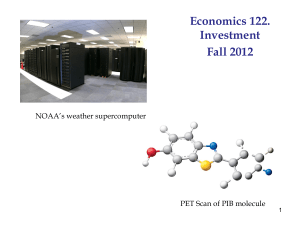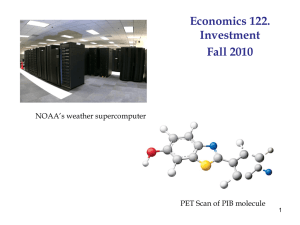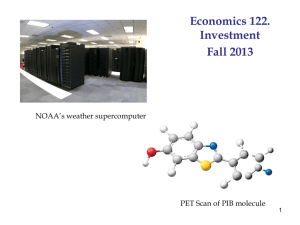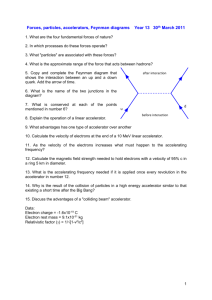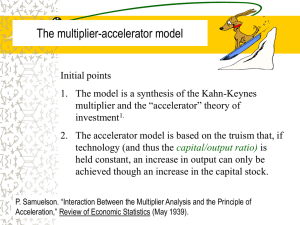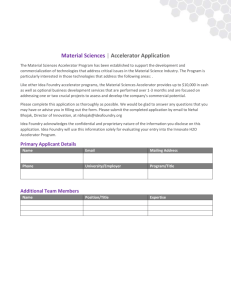Inv_2009_post
advertisement
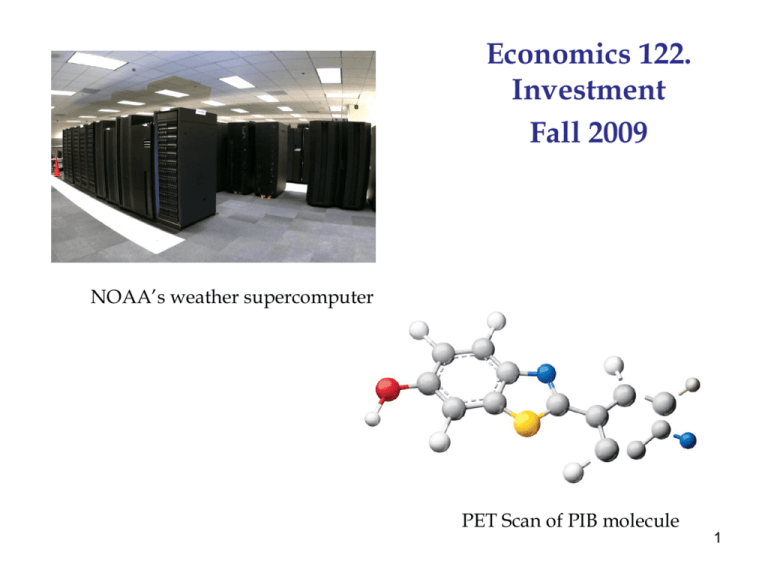
Economics 122. Investment Fall 2009 NOAA’s weather supercomputer PET Scan of PIB molecule 1 The Macroeconomics of Investment Capital • Produced, durable, used for further production • Examples: – tangibles (structures, equipment) – intangibles (software, patents) Basic role of investment in macro • Short run: most volatile part of aggregate demand – Recall decline of I in Great Depression • Long run: key determinant of growth of potential output and major way that governments affect economic growth. 2 Investment decline in the Depression 1.4 Real GDP (1929 = 1) Real I (1929 = 1) 1.2 1.0 0.8 0.6 0.4 0.2 0.0 29 30 31 32 33 34 35 36 37 38 39 40 Note on data: Very convenient place is “FRED”: http://research.stlouisfed.org/fred2 3 Investment-GDP ratio Investment/GDP (nominal $) .20 .18 .16 .14 .12 .10 60 65 70 75 80 85 90 95 00 05 10 Shaded areas are NBER recessions 4 Today’s housing crunch Housing Starts / Population .014 .012 .010 .008 .006 .004 .002 .000 60 65 70 75 80 85 90 95 00 05 10 5 The major theories of investment 1. Accelerator theory: states that investment is a function of change in output 2. Neoclassical theory: Desired capital stock a function of output and cost of capital 3. Q theory: Investment a function of Tobin’s Q (Q =ratio of market value of K to replacement cost) 6 1. Accelerator Theory - Oldest and simplest theory is the accelerator model. - Here, the idea is that there is a target capital-output ratio K* = v Y - Hence the desired change in investment is equal to the change in output (I is gross investment): I* = ΔK* + δK = v Δ Y + δK - The actual investment might differ from the desired, but this is a simple and useful model. It shows why there is a close relationship between investment and output change. 7 Isoquants with fixed capital-output ratio L fixed K/L ratio in accelerator K 8 Graph shows relation between investment and change in output (accelerator model) I δK+vΔY δK ΔY 9 2. Neoclassical Theory The mainstream theory is the neoclassical model. - This is closely related to the accelerator model. - The difference is that in the neoclassical model there is a variable capital-output ratio - Hence, K/Y depends upon relative factor prices, and in particular upon the user cost of capital and taxes. Using standard production theory Start with aggregate production function: Y = F(K,L) Next figure shows the difference of the accelerator and neoclassical models for an isoquant. 10 Isoquants with fixed capital-output ratio v. variable proportions L fixed K/L ratio in accelerator Cobb-Douglas in neoclassical K - fixed K/L corresponds to accelerator model - variable proportions (such as Cobb-Douglas) corresponds to neoclassical model 11 Investment Criteria There are a number of return concepts. – – – – present value (V0 today) internal rate of return (i per year) rental price of capital ($ per apartment per month) cost of capital (usually, “user cost of capita”) • • • • Central concept in macro theories of investment Def. Cost of renting capital for one period Appropriate for perfect capital market. Estimate as imputed in most circumstances because firms own capital (also for housing in NIPA) 12 Formula for cost of capital u ≈ (1+τ) pK [r + δ] where u = user cost of capital pK = price of capital good r = real interest rate δ = depreciation rate τ = effective rate of tax (or subsidy when negative) on capital goods Linkage to policy: - through real interest rate - through taxation of capital In practice, u is complicated to measure; off to B School! 13 Derivation and example: • Buy a car, rent it for one period, and then sell at the end. No inflation or taxes. r = .05. • Pay $20,000 sell for 20,000(1-.1) = $18,000; collect rent u. • What cost of capital (u) would just break even? when pK = pK (1- δ)/(1+r) + u 20,000 = 18,000/(1.05) + u Solve for break-even (competitive-market) rental: u = 20,000 – 18,000/1.05 = 20,000 – 17,143 = 2857 ≈ pK (r+ δ) = 20,000(.15) = 3,000 14 Cost of capital with no taxes and P = 1 This is a slightly more realistic version that has both debt and equity capital. 11 Real cost of capital (% per year) 10 9 8 7 6 5 85 4 90 3 50 95 55 60 00 65 70 05 75 80 10 85 90 95 00 05 10 15 Basic approach in the neoclassical model We start with a production function; and then derive the demand for capital. Demand for capital: Assume a Cobb-Douglas production function Y = A Kβ L1-β Then derive the value of MPK: p MPK = p ∂Y/∂K=p βA Kβ-1 L1-β = pβY/K Finally, the firm sets its desired capital stock (K*) by equating the cost of capital to the MPK: u =p∂Y/∂K=pβY/K Now normalize prices = 1 for simplicity and ignore taxes: u = (r+δ) = βY/K 16 This yields a demand for capital (K*): K* = βY/(r+δ) Note the various components of the demand for capital – – – – output (like accelerator) interest rate (r) depreciation rate (δ) With taxes: K* = βY/[(r+δ) (1+τ)] 17 - Note that the impact of interest rates on investment is powerful but depends importantly on the lifetime of the capital: User cost of capital Change in user Depreci- (per $ capital) cost with increase Lifetime ation rate at real interest rate: in r from 2% to 4% Investment item (years) 2% 4% δ Structures 50 0.02 4% 6% 50.0% Major equipment 10 0.10 12% 14% 16.7% Computers 3 0.40 42% 44% 4.8% Inventories 1 1.00 102% 104% 2.0% - Where biggest impacts? Housing - Where smallest? Computers and inventories 18 From demand for capital to demand for investment • How do we get investment demand (or equilibrium investment)? • Generally, go from demand for capital to demand for investment • Several approaches: - Costs of adjustment of investment - Capacity in the capital goods industry (Boeing aircraft) - Construction lags (power plants) - Internal funds constraint 19 3. Q theory of investment Idea here is that investment is determined by relationship between the value of firms or houses and the cost of new or replacement capital. Keynes: “The daily revaluations of the Stock Exchange, though they are primarily made to facilitate transfers of old investments between one individual and another, inevitably exert a decisive influence on the rate of current investment. For there is no sense in building up a new enterprise at a cost greater than that at which a similar existing enterprise can be purchased; whilst there is an inducement to spend on a new project what may seem an extravagant sum, if it can be floated off on the Stock Exchange at an immediate profit.” Tobin: "It is common sense that the incentive to make new capital investments is high when the securities giving title to their future earnings can be sold for more than the investments cost, i.e., when q exceeds one." 20 The collapse in shipping prices on dry cargo 21 A glut of cargo ships 22 More formally: Q = (market value of K)/(replacement cost of K) Example: - Cargo ships are selling for a Q of 0.25 - E.g., cost of production is $20 million, but ships sell for $5 million - How is this possible? • Inelastic supply and high demand for cargo → low rentals • PV of ships is low. • Therefore, little to no shipbuilding, and the stock gradually depreciates or is scrapped How does Q affect investment? - Because Q < 1, shipping firms buy old ships rather than build new ones - This depresses investment. - Therefore I/K = f(Q), f’(Q) > 0. 23 Rental of ships S2009 Current ship rental Demand for shipping Number of ships 24 Rental of ships Sfuture S2009 “cost of capital” for new ships Current ship rental Demand for shipping Number of ships 25 Q I/K = f (Q) 1 I/K δ 26 Investment ratio and Q for housing 1.7 900 I housing (right scale) 1.6 800 1.5 Q of housing Residential construction (2005 $) 1.4 700 1.3 600 Q (left scale) 1.2 1.1 500 1.0 400 0.9 0.8 Housing bubble: 1.Note that Q rose about 50 percent from mid-1990s. 2. Note huge decline in residential construction (I) 88 90 92 94 96 98 00 02 04 06 08 10 300 27 Summary of investment theory 1.. The major components of investment are residential, business plant and equipment, software, and inventories. 2. These are among the most volatile components of output in the short run. 3. In equilibrium, demand for capital determined where the cost of capital equals the marginal productivity of capital. 4. The major theories are the accelerator theory, the neoclassical theory, and the Q theory. These apply differently in different sectors. 5. Economic policy affects investment through both monetary and fiscal policy: • monetary policy through real interest rate and stock prices • fiscal policy through things like depreciation policy and investment tax credits. 28
